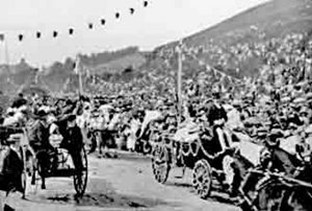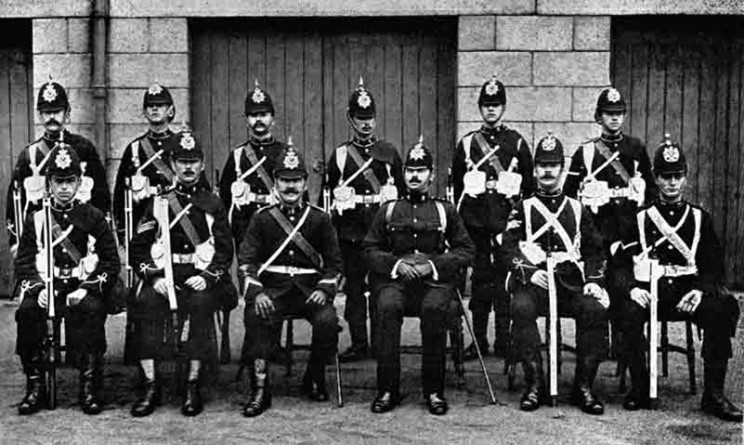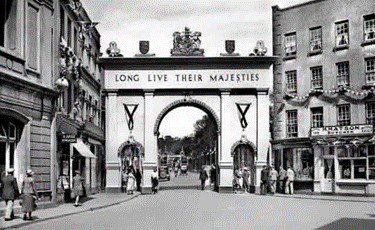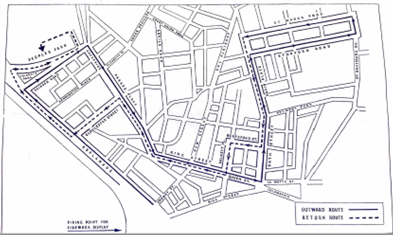A brief history of how coronations have been noted and celebrated in Jersey.
Jersey has a close relationship with the Crown and has participated in many coronation celebrations. This briefing paper examines how Jersey celebrated, noted, and in some cases partook, in the coronations of new Monarchs.
King Edward VII and the First Battle of Flowers [1902]
The Battle of Flowers was originally created as a way for the Island to celebrate the coronation of King Edward VII.
Following the death of Queen Victoria, the Fêtes Committee was given a brief to create an event to celebrate the first coronation in 60 years. As well as decorating St Helier with arches and flowers, a special floral parade ran on the day of the coronation itself. [1]

[1] Jersey Battle of Flowers - Jerripedia (theislandwiki.org)
Jersey Militia and Edward VII's Coronation [1902]
A small contingent of the Jersey Militia were selected to travel to London to be a part of King Edward VII's coronation. However, as the soon-to-be King fell ill the Militia contingent had to return to Jersey as soon as they got to London.
Once the new date had been settled a smaller contingent of the Jersey Militia were sent over again and were able to partake in the coronation of the new King. Below is a photo of the group who attended –

King George VI Cinefilm [1937]
A 'Cine Film' was shot by the former Evening Post editor Arthur Harrison which captured how St Helier was decorated to celebrate the coronation of King George VI. It shows the arches and bunting that were common in Jersey for all the coronations mentioned in this briefing paper. It is available at the following link King George VI Coronation celebrations in St Helier, Jersey, 1937.
Coronation arches were erected in multiple locations across the Island.
The image below shows the large arch constructed between York Street and
the Parade in 1937.

Coronation Park [1937]
Coronation Gardens (more commonly referred to as Millbrook Park) was opened in 1937 by Lady Florence Trent to celebrate the coronation of George VI. She gifted the land, which she had already developed into gardens, to the Island with a note to the Bailiff describing it as a "a Coronation gift to the Island, to be kept as an open space forever ... As a resting place for older people, and as a recreation place for the young ones."[1] More information on the park can be found in its Historic Environment Record entry.
[1] "Heritage Asset – Coronation Park, La Route de St Aubin," Historic Environment Record, accessed 14/04/2023 Arches - Resource Report (jerseyheritage.org)
The Coronation of Queen Elizabeth II [1953]
The first act of celebration for the coronation of Queen Elizabeth occurred on 5th March 1953, when it was announced that 2nd June 1953 would be a bank holiday. This was decided following recommendations from the Memorial and Coronation Committee. This Committee was originally established to assist in the Island's participation of the funeral planning for the late King.
The States of Jersey were allocated 20 tickets for the Coronation at a total cost of £96 (£2131.55). After being allocated to States Member, an application process was opened for the allocation of the remaining tickets. The groups who were successful in their application, and provided 2 tickets each, were:
- Royal Jersey Agricultural and Horticultural Society
- Jersey Civil Service
- Jersey Swimming Club
- Jersey Round Table
- Inner Wheel Club
- The Salvation Army
On Island, there was a variety of celebrations planned. This started with a parade by the Band of the 1st Kings Royal Rifle Corps to People's Park. Following this, Islanders gathered in both People's Park and Howard Davis Park at 11am for the relay of the official coronation ceremony from Westminster Abbey.
Following this, a cavalcade set off from the Grand Hotel taking a tour through town eventually also ending at People's Park. Once the Cavalcade arrived, there was music from the Band of the 1st Kings Royal Rifle Corps.
Below is a map of the route the Cavalcade took:

Whilst this was happening there was also an Elizabethan Fete at Howard Davis Park.
At 8:55pm in both parks there was a relay of a broadcast from the newly crowned Queen and the prime minister.
Jersey was also the southerly most point of a chain of beacons running through the entire British islands. These beacons were to be lit in a chain to mark the coronation. Jersey's beacon was 45ft tall and sat at St Aubin's Fort. This beacon was the crescendo of events for the day; at 10:25pm the beacon was lit by the Boy Scouts and soon after a "Grand Firework Display" was launched from the Fort.
To close the day, there was open-air dancing in People's Park.
A timeline of the events of the day can be found in the programme provided to the people of Jersey:

Each Parish was instructed to make its own arrangements regarding decorations. However, any designs for souvenirs had to be submitted to the Coronation Souvenirs Committee to ensure they were of a high standard and good quality.
The Parishes were also instructed to provide "tea and sports for the children", which would be subsidised by the States. Alongside this, each child was provided with a 'Coronation Medal'.
There was also a special Air Display to celebrate the event. This air display involved the new Jersey Airlines aircraft as well as a flypast from 12 Belgian Thunderjets performing a simulated strafing run on the airport.
Coronation Honours
As a part of her coronation, Queen Elizabeth II provided appointments to many different organisations and honours. Amongst the extensive list there were 3 people from Jersey; their names, titles, and the appointment granted are provided below:
- Philip Le Feuvre, Senator of the States of Jersey (OBE)
- Stuart Philip Pepin, for public services in Jersey (OBE)
- Thomas Small, Plant Pathologist to the States of Jersey (OBE)
Coronation Memorabilia
To mark the Coronation of new monarchs it was common for items of memorabilia to be created. To mark the coronations of King Edward VII, King George V and King George VI, a special coin was produced.
Coronation Medals were also produced for King George VI and Queen Elizabeth II. To mark Queen Elizabeth II's coronation all children were given this special Coronation Medal. The idea of giving each schoolchild a medal was raised in a meeting of the Memorial and Coronation Sub-Committee on 25th October 1952.
